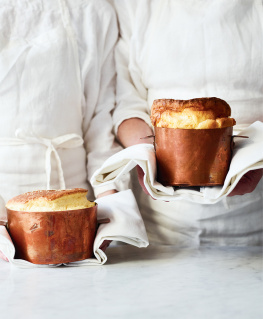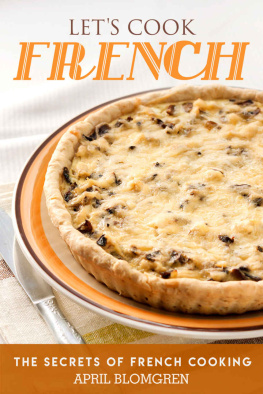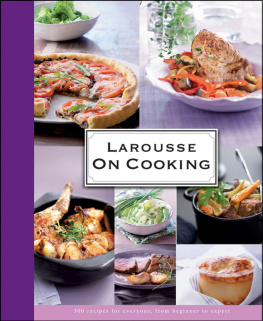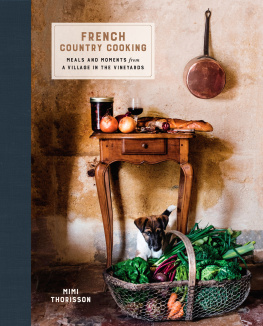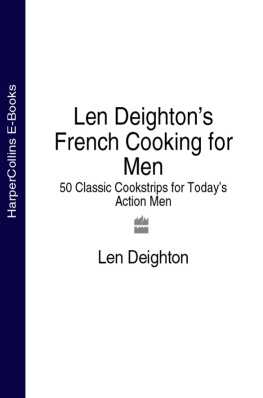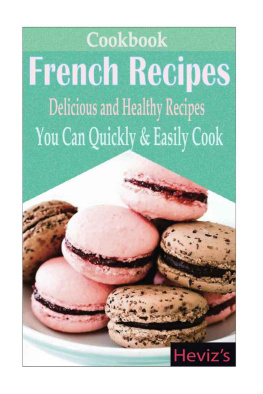


CONTENTS
THE RECIPES

INTRODUCTION
THE STORY OF THE COOKS ATELIER
In the heart of Beaune, just past the Place au Beurre, is a pretty little shop with slate-gray shutters and a vintage bakers bicycle filled with flowers parked beside the front door. Gleaming copper pots hang in the shop windows above iron tables displaying cooks toolsnarrow wooden rolling pins, copper-handled whisks, vintage chefs knives and cleavers, and marble mortars and pestles. A handwritten quote by Julia Child graces the window: People who love to eat are always the best people. The name of this place, stated simply on a patinaed copper sign, is The Cooks Atelier.
Inside, sounds of old-time French jazz float through the air, and an aroma of baking madeleines wafts down from the kitchen above. Clanks of pots and pans and the rhythmic chop-chopping of knives on wooden cutting boards blend with the whir of grinding coffee beans and the hiss of the vintage Italian espresso machine. The rustic stone walls of the wine shop are hung with simple wrought-iron racks, displaying a carefully curated selection of small-production wines from France, Italy, and Germany. Everywhere is the evidence of a copper obsession: jam pots and fish poachers, tall stockpots, cake molds, and every shape and size of saut pan and saucepot imaginable.
In the back of the shop, the light-filled atrium is full of more culinary treasures vendre (for sale)stacks of old and new wooden cutting boards, vintage madeleine tins, and a collection of creamy white ironstone soup tureens. Zinc pitchers filled with freshly cut flowers sit near a collection of restored mezzalunas and bone-handled French cheese knives. An old butchers scale sits atop a farm table, surrounded by stacks of linen kitchen towels and preserving crocks full of wooden cooks tools like olive-wood spoons, spatulas, and citrus reamers. A small selection of well-sourced pantry items lines the wall: extra-virgin olive oil from the South of France, aged vinegars from Banyuls, vanilla beans from Madagascar, local Burgundian grainy mustard and honey, salted capers from Sicily, and a mix of spices. Its a shop for cooks, created by cooks.
A heavy wooden spiral staircaseoriginal to the seventeenth-century buildingleads up to the second-floor all-white kitchen. A neat row of vintage carbon steel chefs knives adorns one wall, and bright copper pots hang over a Lacanche range. The kitchen is bustling with a cooking class underway. Ten guests from around the world, decked in linen aprons, gather around the marble-topped prep table, busily making lunch from baskets of fresh ingredients just purchased at the market. Platters contain neat rows of scored duck breasts, ready to pan-sear. The students tightly pack caramelized red and golden plums into a heavy cast-iron skillet and cover them with a sheet of homemade pte feuillete (puff pastry). Chanterelles sizzle with garlic and shallots, and a pot of bright orange potimarron (winter squash) soup simmers on the back of the stove. A selection of farm cheeses sits on a vintage board, waiting to be served after the main course.
Once the cooking is done, aprons come off, and guests climb another staircase up to the third-floor dining room, where a wall of windows overlooks the atrium below. A zinc-topped table is set for lunch in simple French fashion. A gray armoire stands against the wall, displaying a collection of favorite antique treasures, thirty years in the making: shelves of crystal stemware, mismatched stacks of creamy white vintage caf au lait bowls, a collection of confiture (jam) jars filled with flatware, and one-of-a-kind flea market finds, like French creamware, silver spoons, and tiny copper molds. Candles are lit and Champagne glasses are filled as guests toast one another in anticipation of the long French lunch.
HOW WE CAME TO LOVE FRANCE
People ask us all the time how two American womena mother and daughter, nonethelessended up creating a French cooking school in Burgundy. Its a long story, but one we love telling, as it reminds us that, with enough determination and grit, anything is possible.
Our vision for this place started more than twenty years ago, when we were still living in Arizona. Kendall was always a Francophile, even as a little girl. We arent entirely sure how that happened, considering we were both born and raised in Phoenixwhich, in more ways than one, is a very long way away from Beaune. In high school, she studied French and had a very memorable teacher whose own experience in France resonated with her. After a trip to Paris for the first time with her high school class, the spark was officially ignited. She became intrigued with everything about Francethe language, the culture, and the food. On early morning walks together before work and school, our talks often centered around France and the idea of joie de vivrethe way French people take time to savor everything, be it a coffee, a meal, or a conversation. We tried to adopt this philosophy as best we could in our everyday lives, never imagining that we would ever actually live in France one day.



As the years went by, Kendall began spending more and more time in France. She studied French and art history at university, and took every opportunity to study abroad in college. After graduating, she returned to France to teach English in Nmes. A year later, she moved to Paris and got an internship at Christies auction house, working part-time on the side to pay the rent. She lived in a tiny 205-square-foot (19-square-meter) apartmentroughly the size of a laundry room. She stayed in Paris for several years, working and studying, and I visited her as often as I could.
Since it had always been just the two of us, it was hard to live an ocean apart. Her dad had passed away when she was a little girl, so I raised Kendall predominately as a single parent. I always encouraged her to follow her dreams, and I knew it was just a matter of time until she figured out a way to settle in France permanently.
A LOVE FOR FOOD AND WINE
Ive always loved feeding people and gathering others around the table. Although I come from a large family, where big holiday gatherings were a normal part of growing up, the food prepared was never really the focus. I certainly didnt come from a long line of great cooks, and so I spent many years teaching myself. Ive always been hugely inspired by the writings of Julia Child, M. F. K. Fisher, Elizabeth David, Madeleine Kamman, and Alice Waters, and essentially taught myself to cook following many of their recipes. I admired their passion and the way they described how to cook in detail, using the techniques required to prepare each recipe by hand. Of course, these women all happened to be Francophiles, and Im sure its not by accident that Ive always felt connected to French food in the same way that Kendall has been drawn toward France. One of my very favorite cookbooks is
Next page


